Coxeter element
In mathematics, the Coxeter number h is the order of a Coxeter element of an irreducible Coxeter group. It is named after H.S.M. Coxeter.[1]
Definitions
Note that this article assumes a finite Coxeter group. For infinite Coxeter groups, there are multiple conjugacy classes of Coxeter elements, and they have infinite order.
There are many different ways to define the Coxeter number h of an irreducible root system.
A Coxeter element is a product of all simple reflections. The product depends on the order in which they are taken, but different orderings produce conjugate elements, which have the same order.
- The Coxeter number is the number of roots divided by the rank. The number of reflections in the Coxeter group is half the number of roots.
- The Coxeter number is the order of any Coxeter element;.
- If the highest root is ∑miαi for simple roots αi, then the Coxeter number is 1 + ∑mi
- The dimension of the corresponding Lie algebra is n(h + 1), where n is the rank and h is the Coxeter number.
- The Coxeter number is the highest degree of a fundamental invariant of the Coxeter group acting on polynomials.
- The Coxeter number is given by the following table:
| Coxeter group | Coxeter diagram |
Dynkin diagram |
Coxeter number h |
Dual Coxeter number | Degrees of fundamental invariants | |
|---|---|---|---|---|---|---|
| An | [3,3...,3] | n + 1 | n + 1 | 2, 3, 4, ..., n + 1 | ||
| Bn | [4,3...,3] | 2n | 2n − 1 | 2, 4, 6, ..., 2n | ||
| Cn | n + 1 | |||||
| Dn | [3,3,..31,1] | 2n − 2 | 2n − 2 | n; 2, 4, 6, ..., 2n − 2 | ||
| E6 | [32,2,1] | 12 | 12 | 2, 5, 6, 8, 9, 12 | ||
| E7 | [33,2,1] | 18 | 18 | 2, 6, 8, 10, 12, 14, 18 | ||
| E8 | [34,2,1] | 30 | 30 | 2, 8, 12, 14, 18, 20, 24, 30 | ||
| F4 | [3,4,3] | 12 | 9 | 2, 6, 8, 12 | ||
| G2 | [6] | 6 | 4 | 2, 6 | ||
| H3 | [5,3] | - | 10 | 2, 6, 10 | ||
| H4 | [5,3,3] | - | 30 | 2, 12, 20, 30 | ||
| I2(p) | [p] | - | p | 2, p | ||
The invariants of the Coxeter group acting on polynomials form a polynomial algebra whose generators are the fundamental invariants; their degrees are given in the table above. Notice that if m is a degree of a fundamental invariant then so is h + 2 − m.
The eigenvalues of a Coxeter element are the numbers e2πi(m − 1)/h as m runs through the degrees of the fundamental invariants. Since this starts with m = 2, these include the primitive hth root of unity, ζh = e2πi/h, which is important in the Coxeter plane, below.
Group order
There are relations between group order, g, and the Coxeter number, h:[2]
- [p]: 2h/gp = 1
- [p,q]: 8/gp,q = 2/p + 2/q -1
- [p,q,r]: 64h/gp,q,r = 12 - p - 2q - r + 4/p + 4/r
- [p,q,r,s]: 16/gp,q,r,s = 8/gp,q,r + 8/gq,r,s + 2/(ps) - 1/p - 1/q - 1/r - 1/s +1
- ...
An example, [3,3,5] has h=30, so 64*30/g = 12 - 3 - 6 - 5 + 4/3 + 4/5 = 2/15, so g = 1920*15/2= 960*15 = 14400.
Coxeter elements
Coxeter elements of , considered as the symmetric group on n elements, are n-cycles: for simple reflections the adjacent transpositions , a Coxeter element is the n-cycle .[3]
The dihedral group Dihm is generated by two reflections that form an angle of , and thus their product is a rotation by .
Coxeter plane

For a given Coxeter element w, there is a unique plane P on which w acts by rotation by 2π/h. This is called the Coxeter plane and is the plane on which P has eigenvalues e2πi/h and e−2πi/h = e2πi(h−1)/h.[4] This plane was first systematically studied in (Coxeter 1948),[5] and subsequently used in (Steinberg 1959) to provide uniform proofs about properties of Coxeter elements.[5]
The Coxeter plane is often used to draw diagrams of higher-dimensional polytopes and root systems – the vertices and edges of the polytope, or roots (and some edges connecting these) are orthogonally projected onto the Coxeter plane, yielding a Petrie polygon with h-fold rotational symmetry.[6] For root systems, no root maps to zero, corresponding to the Coxeter element not fixing any root or rather axis (not having eigenvalue 1 or −1), so the projections of orbits under w form h-fold circular arrangements[6] and there is an empty center, as in the E8 diagram at above right. For polytopes, a vertex may map to zero, as depicted below. Projections onto the Coxeter plane are depicted below for the Platonic solids.
In three dimensions, the symmetry of a regular polyhedron, {p,q}, with one directed petrie polygon marked, defined as a composite of 3 reflections, has rotoinversion symmetry Sh, [2+,h+], order h. Adding a mirror, the symmetry can be doubled to antiprismatic symmetry, Dhd, [2+,h], order 2h. In orthogonal 2D projection, this becomes dihedral symmetry, Dihh, [h], order 2h.
| Coxeter group | A3, [3,3] Td |
B3, [4,3] Oh |
H3, [5,3] Th | ||
|---|---|---|---|---|---|
| Regular polyhedron |
 {3,3} |
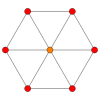 {4,3} |
 {3,4} |
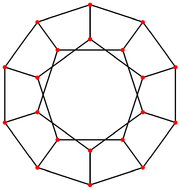 {5,3} |
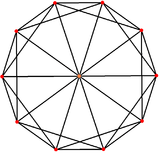 {3,5} |
| Symmetry | S4, [2+,4+], (2×) D2d, [2+,4], (2*2) |
S6, [2+,6+], (3×) D3d, [2+,6], (2*3) |
S10, [2+,10+], (5×) D5d, [2+,10], (2*5) | ||
| Coxeter plane symmetry |
Dih4, [4], (*4•) | Dih6, [6], (*6•) | Dih10, [10], (*10•) | ||
| Petrie polygons of the Platonic solids, showing 4-fold, 6-fold, and 10-fold symmetry. | |||||
In four dimension, the symmetry of a regular polychoron, {p,q,r}, with one directed petrie polygon marked is a double rotation, defined as a composite of 4 reflections, with symmetry +1/h[Ch×Ch][7] (John H. Conway), (C2h/C1;C2h/C1) (#1', Patrick du Val (1964)[8]), order h.
| Coxeter group | A4, [3,3,3] | B4, [4,3,3] | F4, [3,4,3] | H4, [5,3,3] | ||
|---|---|---|---|---|---|---|
| Regular polychoron |
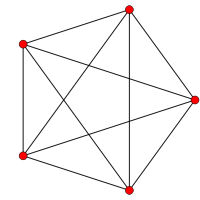 {3,3,3} |
 {3,3,4} |
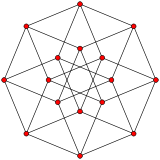 {4,3,3} |
 {3,4,3} |
 {5,3,3} |
 {3,3,5} |
| Symmetry | +1/5[C5×C5] | +1/8[C8×C8] | +1/12[C12×C12] | +1/30[C30×C30] | ||
| Coxeter plane symmetry |
Dih5, [5], (*5•) | Dih8, [8], (*8•) | Dih12, [12], (*12•) | Dih30, [30], (*30•) | ||
| Petrie polygons of the regular 4D solids, showing 5-fold, 8-fold, 12-fold and 30-fold symmetry. | ||||||
In five dimension, the symmetry of a regular polyteron, {p,q,r,s}, with one directed petrie polygon marked, is represented by the composite of 5 reflections.
| Coxeter group | A5, [3,3,3,3] | B5, [4,3,3,3] | D5, [32,1,1] | |
|---|---|---|---|---|
| Regular polyteron |
 {3,3,3,3} |
 {3,3,3,4} |
 {4,3,3,3} |
 h{4,3,3,3} |
| Coxeter plane symmetry |
Dih6, [6], (*6•) | Dih10, [10], (*10•) | Dih8, [8], (*8•) | |
In dimensions 6 to 8 there are 3 exceptional Coxeter groups, one uniform polytope from each dimension represents the roots of the En Exceptional lie groups. The Coxeter elements are 12, 18 and 30 respectively.
| Coxeter group | E6 | E7 | E8 |
|---|---|---|---|
| Graph |  122 |
 231 |
 421 |
| Coxeter plane symmetry |
Dih12, [12], (*12•) | Dih18, [18], (*18•) | Dih30, [30], (*30•) |
See also
Notes
- ↑ Coxeter, Harold Scott Macdonald; Chandler Davis; Erlich W. Ellers (2006), The Coxeter Legacy: Reflections and Projections, AMS Bookstore, p. 112, ISBN 978-0-8218-3722-1
- ↑ Regular polytopes, p. 233
- ↑ (Humphreys 1992, p. 75)
- ↑ (Humphreys 1992, Section 3.17, "Action on a Plane", pp. 76–78)
- 1 2 (Reading 2010, p. 2)
- 1 2 (Stembridge 2007)
- ↑ On Quaternions and Octonions, 2003, John Horton Conway and Derek A. Smith ISBN 978-1-56881-134-5
- ↑ Patrick Du Val, Homographies, quaternions and rotations, Oxford Mathematical Monographs, Clarendon Press, Oxford, 1964.
References
- Coxeter, H. S. M. (1948), Regular Polytopes, Methuen and Co.
- Steinberg, R. (June 1959), "Finite Reflection Groups", Transactions of the American Mathematical Society, 91 (3): 493–504, doi:10.1090/S0002-9947-1959-0106428-2, ISSN 0002-9947, JSTOR 1993261
- Hiller, Howard Geometry of Coxeter groups. Research Notes in Mathematics, 54. Pitman (Advanced Publishing Program), Boston, Mass.-London, 1982. iv+213 pp. ISBN 0-273-08517-4
- Humphreys, James E. (1992), Reflection Groups and Coxeter Groups, Cambridge University Press, pp. 74–76 (Section 3.16, Coxeter Elements), ISBN 978-0-521-43613-7
- Stembridge, John (April 9, 2007), Coxeter Planes
- Stekolshchik, R. (2008), Notes on Coxeter Transformations and the McKay Correspondence, Springer Monographs in Mathematics, doi:10.1007/978-3-540-77398-3, ISBN 978-3-540-77398-6
- Reading, Nathan (2010), "Noncrossing Partitions, Clusters and the Coxeter Plane", Séminaire Lotharingien de Combinatoire, B63b: 32